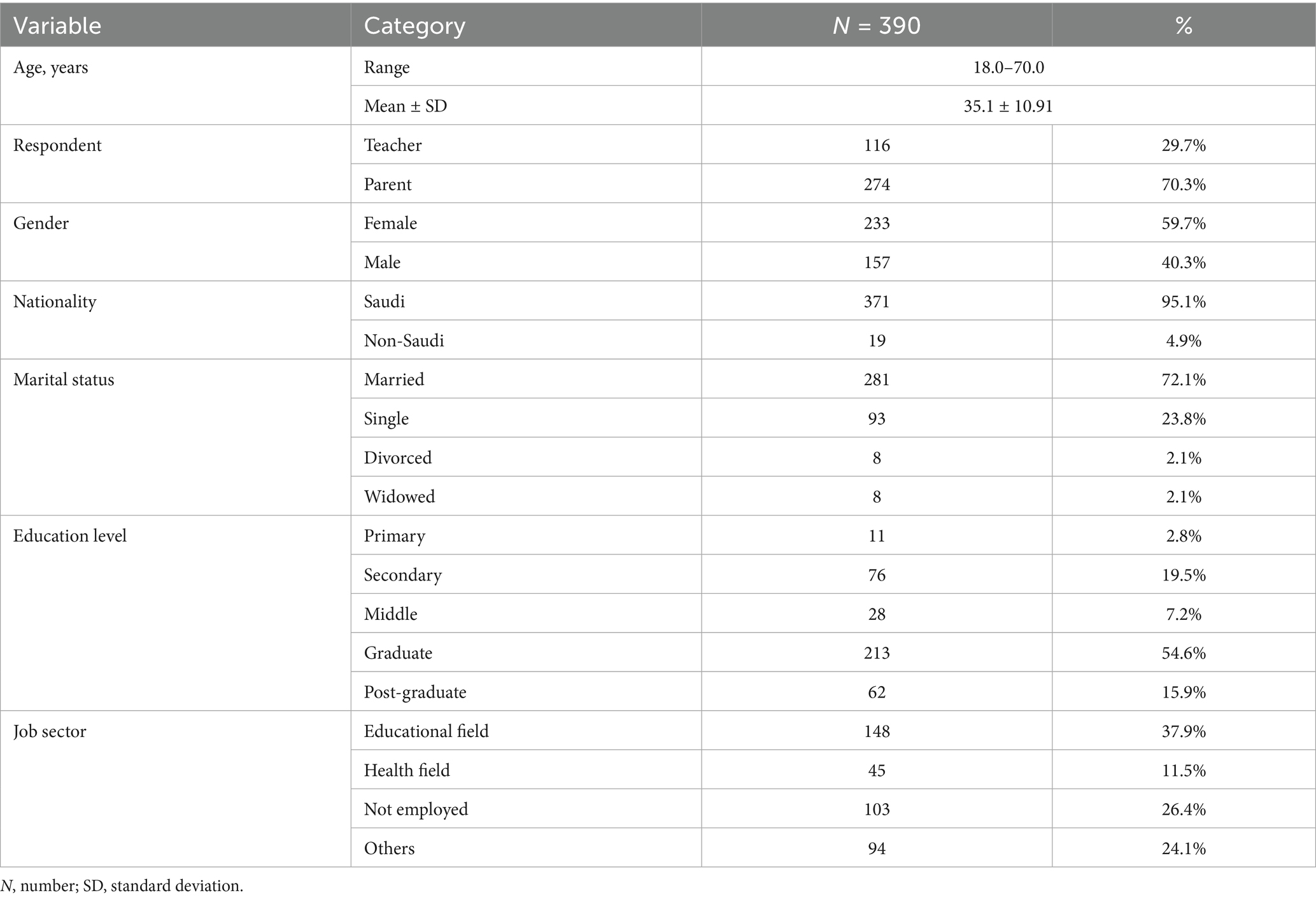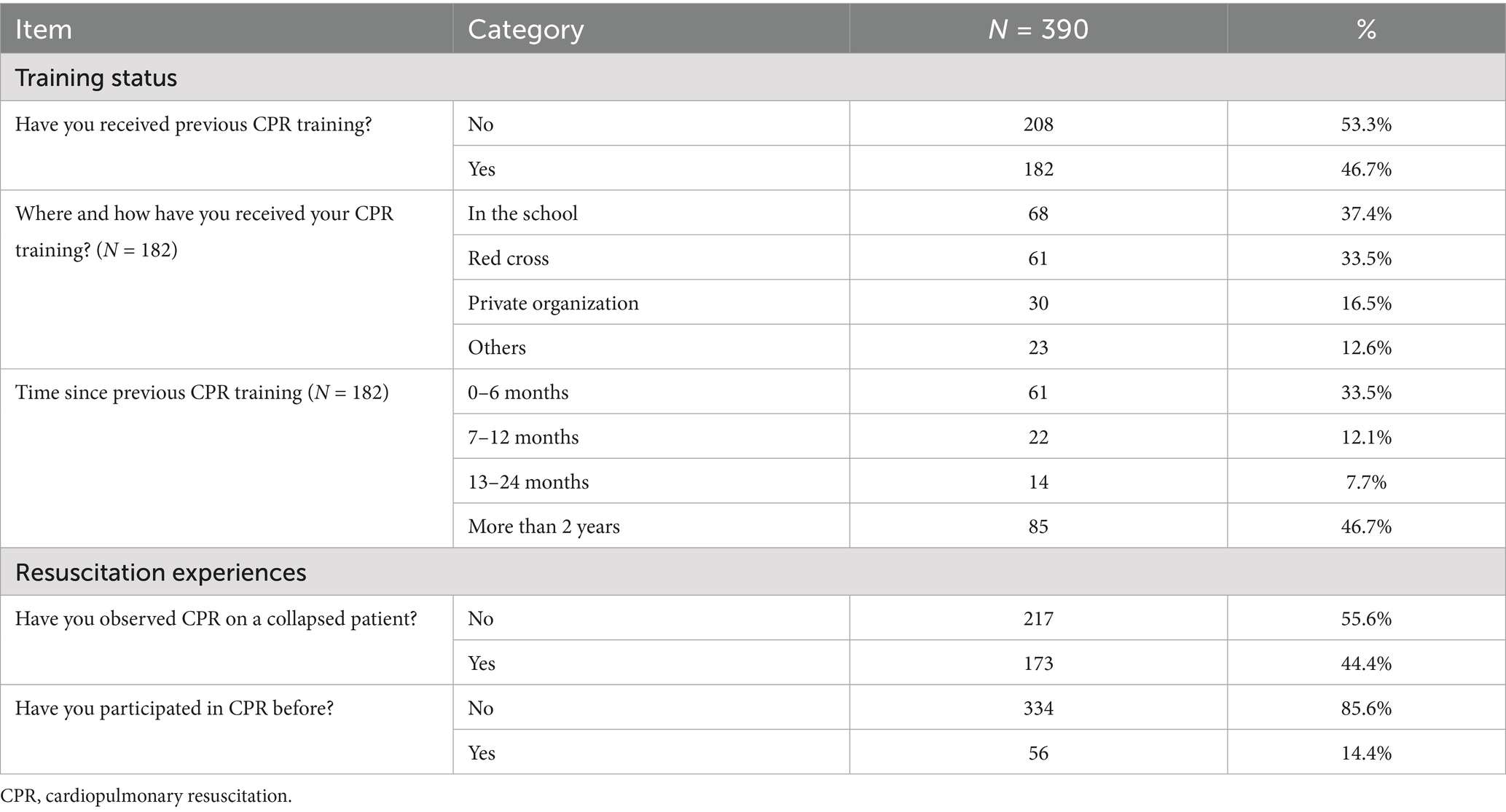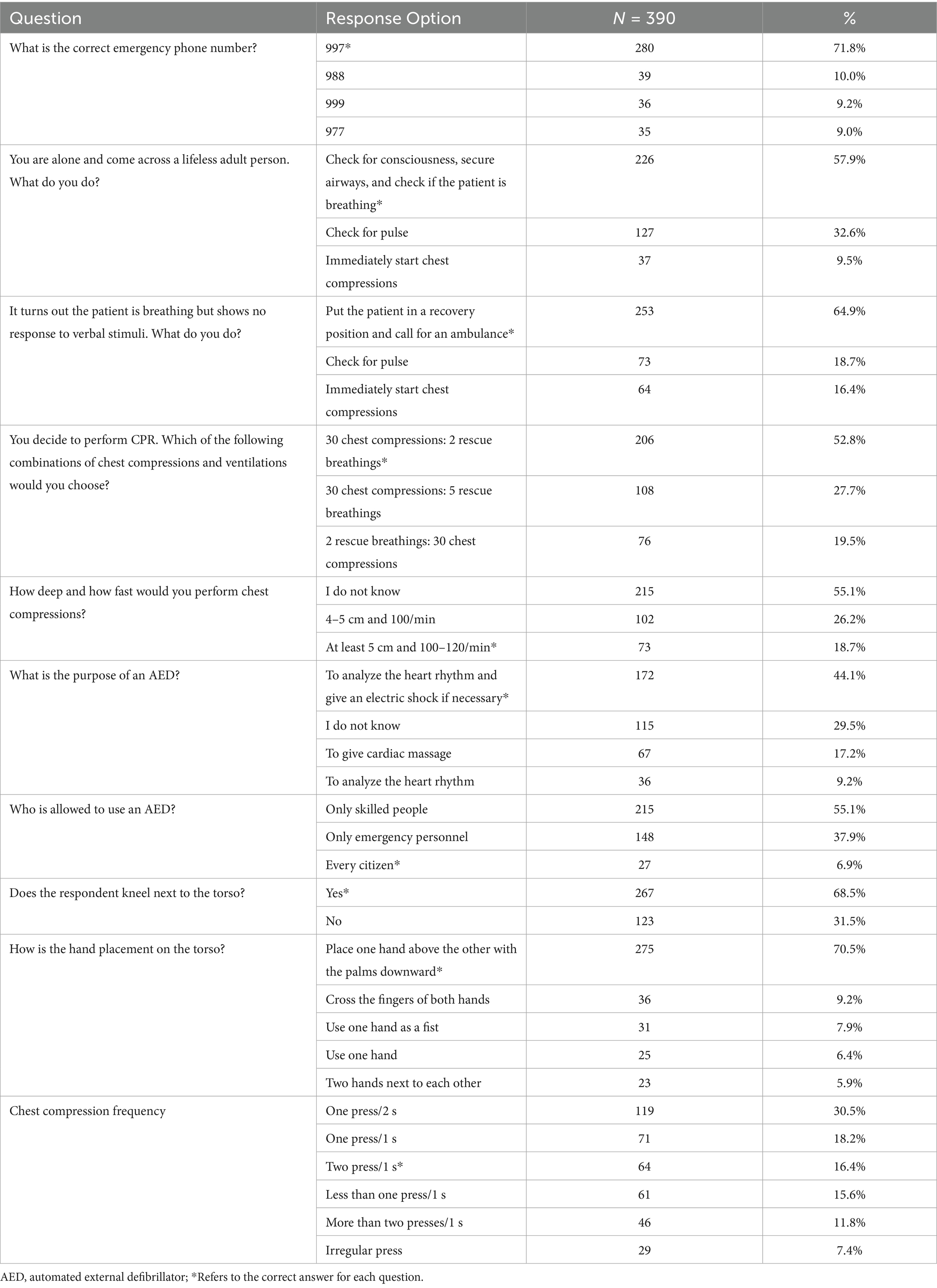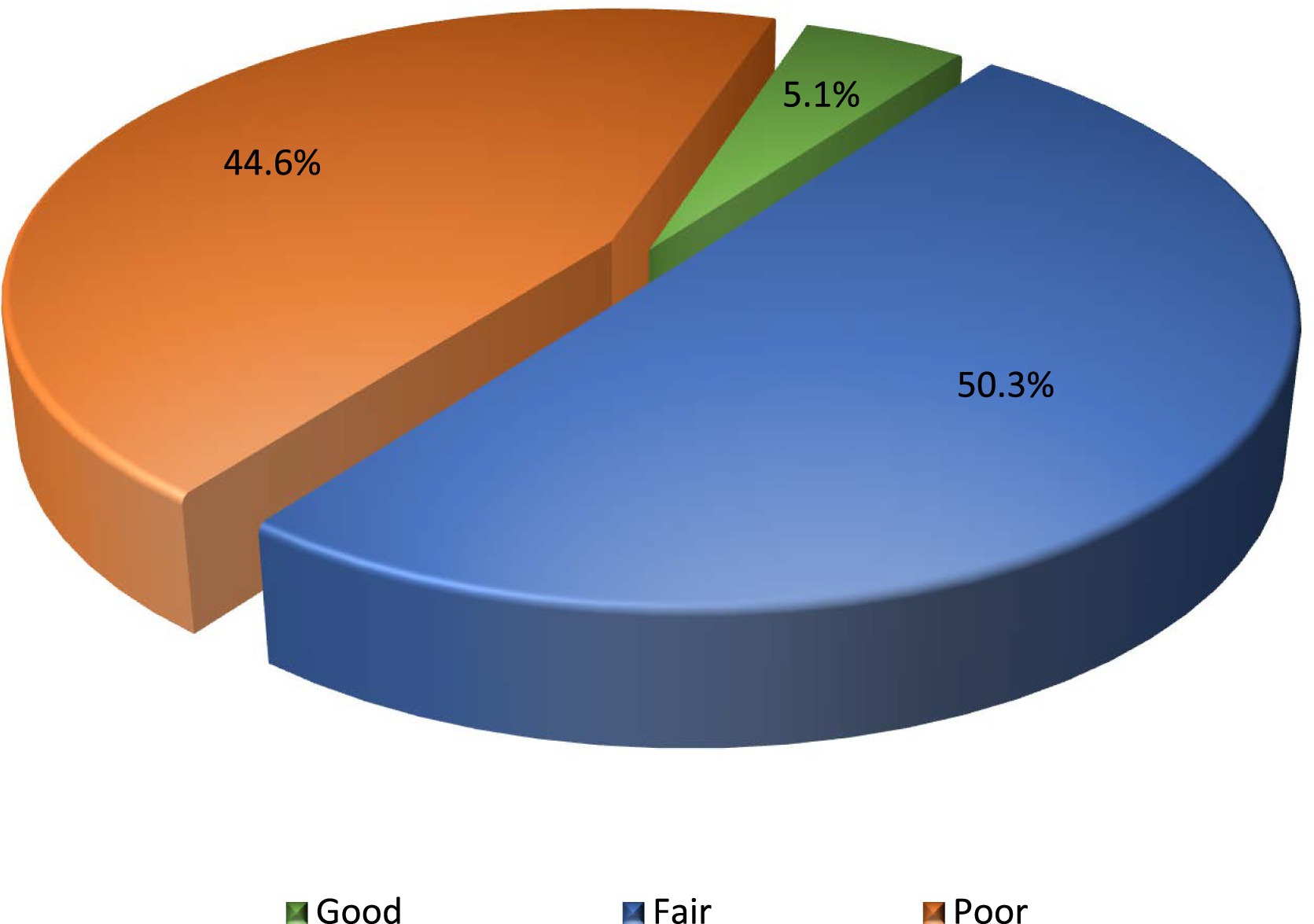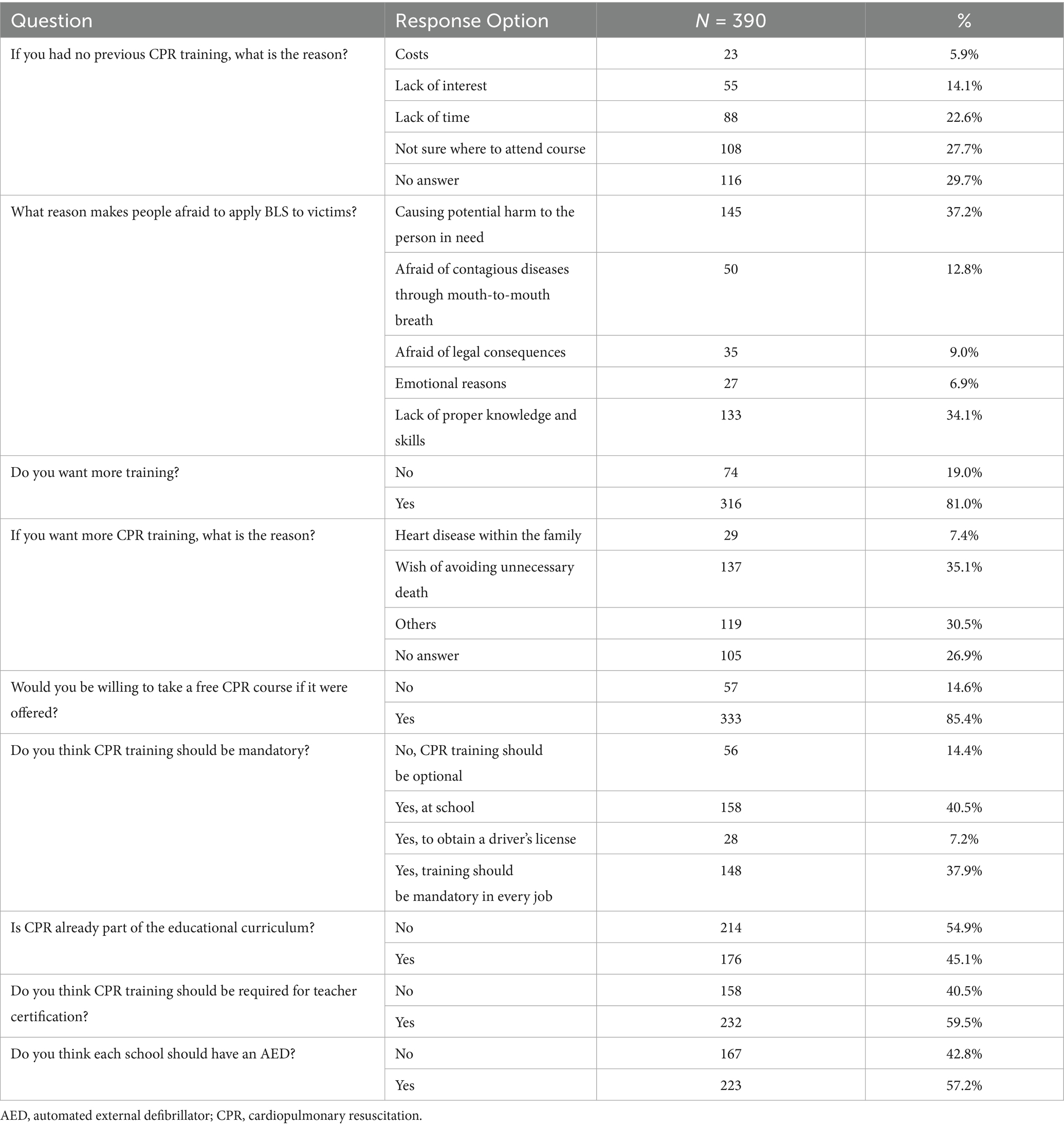- Department of Community and Family Medicine, Faculty of Medicine, University of Tabuk, Tabuk, Saudi Arabia
Background: Assessing the current awareness levels of teachers and parents about basic life support is essential for identifying training gaps, obstacles to acquiring basic life support skills, and areas that require improvement.
Aim: This study aimed to evaluate the knowledge, skills, and attitudes concerning basic life support among kindergarten and primary school teachers and parents in Tabuk City, Saudi Arabia.
Methods: This cross-sectional survey was conducted in Tabuk City, Saudi Arabia, involving teachers and parents of children enrolled in kindergartens or elementary schools, aged 18 years or older. Data were collected using a previously validated, self-administered Arabic questionnaire, distributed through an online link via social media Apps. The total knowledge and skills score was then calculated.
Results: Most participants (70.3%) were parents, with ages ranging from 18 to 70 years and an average age of 35.1 ± 10.91 years. Female participants (59.7%) outnumbered males. Over half (53.3%) had no prior cardiopulmonary resuscitation (CPR) training, and 55.6% had never witnessed CPR being performed. Approximately half (50.3%) demonstrated a fair level of knowledge, while 44.6% had poor levels, and only 5.1% achieved a good level. A significant association was found between previous CPR training and knowledge and skill levels (p < 0.001). Additionally, the majority (81.0%) expressed interest in receiving further CPR training.
Conclusion: This study identified substantial gaps in basic life support awareness and training among kindergarten and primary school teachers and parents in Tabuk City, Saudi Arabia. Most participants exhibited either poor or average levels of knowledge, with critical deficiencies in CPR skills. Prior exposure to CPR training was significantly associated with higher knowledge and skill scores, underscoring the importance of accessible and structured training programs. The main barrier to training was a lack of awareness of available CPR courses. Nevertheless, the high level of expressed interest in future training highlights a strong potential for improving BLS competency through targeted educational initiatives.
Introduction
Numerous child-related medical emergencies requiring instant intervention can occur at schools or homes (1). In such circumstances, teachers and parents share the responsibility of ensuring the safety and well-being of young children as they are frequently the first responders (2). Nevertheless, many teachers and parents lack the necessary training to respond effectively to emergencies, potentially increasing risks for children in critical situations (3, 4).
Basic life support (BLS) is provided by the first responders to assist individuals experiencing cardiac or respiratory arrest, and therefore it is crucial for preserving a child’s life. The emergency procedures provided in BLS include calling local emergency medical services, confirming cardiac arrest, and initiating cardiopulmonary resuscitation (CPR), besides the use of an automated external defibrillator (AED) (5).
It is imperative that non-health professionals, especially school guardians, receive BLS training to ensure the safety of the children. Training more people in CPR is a key part of strategies that improve community response to out-of-hospital cardiac arrests (OHCA). In this context, It has been reported that effective CPR and defibrillation can save half of OHCA (6).
Numerous studies from Greece (7), Belgium (8), Spain (9), and Columbus (3) have found that knowledge levels of BLS among school teachers and community members are inadequate. In addition, studies from Saudi Arabia involving school teachers and public individuals residing in Al-Qassim (10), Al-Khobar (11), Riyadh (12), and Taif (13) cities also documented unsatisfactory levels of knowledge regarding first aid and BLS.
Given the absence of prior studies on this issue in Tabuk City, it is essential to assess the current levels of awareness among teachers and parents regarding BLS. This step is essential to identify gaps in training and barriers to acquiring BLS skills as well as areas for improvement. Subsequently, a structured professional development program for teachers and community awareness initiatives for parents can be established. Therefore, this study aimed to evaluate the knowledge, skills, and attitudes concerning BLS among kindergarten and primary school teachers and parents in Tabuk City, Saudi Arabia.
Methods
Ethical considerations
The study received ethical approval from the Research Ethics Committee at the University of Tabuk, Saudi Arabia. Participants were invited to take part in the research and complete the questionnaire after providing their consent. At the beginning of the survey, the study objectives, methodology, risks, and benefits were explained. To maintain the confidentiality of data and ensure anonymity, each participant was given a unique code number.
Study design, setting, and date
This cross-sectional survey study was carried out in Tabuk City, Saudi Arabia, from November 2024 to January 2025.
Sample size and sampling technique
An online Raosoft sample size calculator “http://www.raosoft.com/samplesize.html” was used to calculate the valid sample size. Considering a 5% margin of error, a confidence interval of 95%, assuming an average response for most of the questions of 50%, and an estimated prevalence of adequate BLS knowledge of 50%, the minimum required sample size was 384 subjects.
A non-probability convenience sampling method was adopted to enroll the participants.
Eligibility criteria
This study included teachers and parents of children attending kindergartens or elementary schools in Tabuk City who were aged 18 years or older, had access to the Internet, and agreed to participate.
Healthcare professionals with advanced BLS certification, respondents residing outside Tabuk City, and those who declined to provide consent or submitted surveys with incomplete data were excluded.
Data collection procedure
After obtaining the ethical approval, data were collected using an online, self-administered questionnaire. The electronic survey was created using Google Forms (https://forms.gle/BY7WBurLgA2GRq2m9), and a link to the survey was disseminated via social media platforms such as “Facebook,” “Twitter,” “Instagram” and “WhatsApp.”
Data collection instrument
A previously validated, self-administered Arabic questionnaire adopted from previous studies (13, 14) was used to collect data. The questionnaire was divided into five sections. The first section gathered the socio-demographic data of the participants. The second section focused on previous CPR training status and included questions about the place and time of training. The third section evaluated the participants’ knowledge and skills in performing BLS. The fourth section showed the attitudes toward training and practicing CPR, where the questions emphasized exploring their willingness and motivation to undergo training. The final section checked the participants’ experience in performing CPR.
The knowledge and skills were assessed by 10 questions, with 1 point for each correct answer and 0 points for each wrong answer. The overall knowledge and skills score was calculated by summing the scores for each item. The possible range of the total score was from 0 to 10 points. Finally, the total knowledge and skills score was categorized as good (8–10 points, 75% correct answers), fair (5–7 points, 50–74.9% correct answers), or poor (0–4 points, <50% correct answers). Regarding the participants’ attitudes, responses with “yes” were deduced as a positive attitude.
Statistical analysis
All data were tabulated and analyzed by the statistical package for the social sciences software program, IBM SPSS Statistics for Windows, version 27 (IBM Corp., Armonk, NY, United States). We presented categorical data as frequencies and percentages and analyzed the possible associations between categorical variables using Pearson’s Chi-Square test. Description of the numerical data was done after checking for normality with the Shapiro–Wilk test and was presented as a mean and standard deviation. A cutoff of p-value less than 0.05 was considered statistically significant.
Results
Table 1 demonstrates that most participants (70.3%) were parents, while 29.7% were teachers. The participants’ ages ranged from 18 to 70 years, with a mean age of 35.1 ± 10.91 years, and female participants (59.7%) outnumbered males. Most participants were Saudi citizens (95.1%). A great proportion of the participants were married (72.1%), while 23.8% were single and a few were divorced or widowed (2.1% each). More than half of the participants (54.6%) were graduates, and a smaller proportion had secondary (19.5%), middle (7.2%), or primary (2.8%) education. The educational field (37.9%) was the main employment sector, followed by non-employed participants (26.4%), and those in other fields (24.1%).
Regarding CPR training status, more than half (53.3%) of the participants lack previous CPR training. Among those who received training (N = 182), the place of training was either the schools (37.4%), the Red Cross (33.5%), or a private organization (16.5%). Strikingly, nearly half (46.7%) had received training more than 2 years ago, while 61 (33.5%) within the past 6 months. Queries about resuscitation experiences revealed that direct exposure to real-life resuscitation is relatively limited among participants where 55.6% had never observed CPR being performed, and only 14.4% of participants had actively participated in performing CPR (Table 2).
Table 3 shows the responses to the knowledge and skills questions. The majority of participants (71.8%) correctly identified 997 as the emergency contact number in Saudi Arabia. When asked about the response to finding a lifeless adult, only 57.9% correctly reported the initial need to check for consciousness, secure the airway, and assess breathing before starting chest compressions. About two-thirds of participants (64.9%) correctly knew that a breathing but unresponsive person should be placed in the recovery position and contact the emergency services. When asked about the correct CPR technique, the correct placement of hands one above the other with palms downward was identified by 70.5, and 68.5% correctly answered that one must kneel next to the torso. Furthermore, 52.8% identified the correct ratio of 30:2 (30 chest compressions to 2 rescue breaths), while only 18.7% correctly answered that compressions should be at least 5 cm deep and at a rate of 100–120 compressions per minute, and only 16.4% properly recognized the recommended frequency of two compressions per second. When asked about AED use, only 44.1% had the correct knowledge that the purpose of AED is to analyze the heart rhythm and deliver an electric shock if necessary. However, only 6.9% correctly answered that any citizen is allowed to use an AED.
Figure 1 illustrates the distribution of participants’ knowledge and skill levels in BLS. About half (50.3%) showed a fair level, while poor levels constituted 44.6% and only a few participants (5.1%) exhibited good levels.
The analysis of the relationships between knowledge and skill levels in BLS and the participants’ sociodemographic characteristics including age, gender, nationality, education level, and job sector revealed the absence of statistically significant associations (All p values >0.05). Alternatively, previous CPR training showed a significant association with knowledge and skill levels (p < 0.001). Most (80%) participants classified as having good BLS knowledge and skills reported having prior CPR training, while 69.0% of those with poor knowledge and skills had never received CPR training as shown in Table 4.

Table 4. Associations between knowledge and skills levels and the participants’ sociodemographic and training characteristics.
Table 5 provides intuition into the participants’ barriers and attitudes toward CPR training and BLS application. The participants who had never received CPR training reported different reasons such as not knowing where to attend a course (27.7%), lack of time (22.6%) or interest (14.1%), or financial costs (5.9%). Asking about the concerns that prevent the participants from performing BLS revealed fear of causing harm to the victim (37.2%) or lack of knowledge and skills (34.1%), besides infection risks (12.8%) and legal concerns (9.0%). Most (81.0%) participants expressed interest in receiving more CPR training, and this frequency was increased to 85.4% if a free CPR course was offered. The main motivation for CPR training was to prevent unnecessary deaths (35.1%). High percentages supported mandatory CPR training either in schools (40.5%), or for all jobs (37.9%). Furthermore, 59.5% supported requiring CPR training for teacher certification, while 40.5% showed a divergent response. More than half (57.2%) believed every school should have an AED, while 42.8% disagreed.
Discussion
This study revealed critical gaps in awareness and training in BLS among kindergarten and primary school teachers and parents in Tabuk City, Saudi Arabia. The majority of participants had either an average level of awareness (50.3%) or lacked the adequate levels necessary for emergencies (44.6%). Only a very small percentage (5.1%) demonstrated a good level. Specific gaps in essential CPR details were identified including the correct compression-to-breath ratio, compression depth and frequency, and the purpose and the person who can use the AED. These findings suggest insufficient or inaccessible current training programs. Moreover, the fact that half (50.3%) of the participants exhibited a “fair” level of knowledge denotes that the current knowledge level may not be strong enough to ensure confident and effective intervention in emergencies. Exploration of the current training status of the participants revealed limited training opportunities where more than half of (53.3%) the participants have never received any formal CPR training, and nearly half (46.7%) of the trained participants had received their CPR training more than 2 years ago. Up-to-date training within the past 6 months was reported by only 33.5% of the respondents. Additionally, the current survey documented limited real-life exposure and hands-on experience in CPR. A substantial number of participants (55.6%) had never observed CPR being performed, and only 14.4% had actively participated in performing CPR.
In agreement with these findings, teachers working in Al-Madinah City (14) and Al-Qassim Region (10), Saudi Arabia exhibited comparable inadequate knowledge of BLS, particularly low knowledge regarding CPR skills and AED use. The majority of teachers also reported having no previous CPR training and most of them had training more than 2 years ago. Another study in Taif City involved 248 teachers and 400 parents established poor knowledge levels about CPR skills among more than 75% of the respondents, with no significant difference between teachers and parents (13). Likewise, studies from Riyadh (12) and Buraidah (15), Saudi Arabia explored the limited availability of CPR courses for school teachers as well as mothers. Internationally, earlier studies from the United Kingdom and the United States also showed low knowledge levels about CPR among teachers (16–18).
The present study also found that BLS knowledge and skill levels are primarily determined by training rather than demographic factors. This underlines the importance of increasing access to CPR training programs to improve overall awareness and skills in BLS. Regular refresher courses are essential as they affect the retention of knowledge and the ability to perform CPR effectively. Organizations and policymakers should prioritize structured CPR training, as well as refresher courses, to ensure a greater number of individuals achieve satisfactory responses in emergencies. Various studies documented a significant association between previous CPR training courses and knowledge levels (2, 19, 20). The necessity of regular CPR training to improve knowledge and skills has been also reported by Nori et al. (21) who also suggested the implementation of BLS courses in the educational curriculum. Furthermore, López et al. (9) and Khademian et al. (22) conducted interventional studies and concluded a positive impact of BLS training on the knowledge and skills of teachers and public individuals with improvement in CPR sequence and quality of chest compression after training. The detected deficiency in knowledge about the AED use in this study should be considered while preparing for the training programs as both high-quality CPR and rapid defibrillation are essential for good outcomes of out-of-hospital cardiac arrest (23, 24).
The present study investigated the key barriers preventing participants from receiving CPR training and performing BLS. Participants stated that they did not attend CPR training because they had no information about the places of the CPR courses. The same reason was reported in previous Saudi studies (10, 14), and a study from Palestine (25). Alternatively, an earlier study from the United States highlighted the financial cost of CPR training as the main barrier (3). In addition, lack of knowledge and skills and fear of causing harm to the victim were the most common reasons for their hesitation in performing BLS measures. This emphasizes the necessity for increasing awareness and hands-on training to boost their confidence.
Most participants in this study showed positive attitudes and strong support for CPR training. Most of them want to learn CPR skills and the main motive for learning was to avoid unnecessary deaths. Similar findings were reported in the previous studies from different countries (8, 10, 14, 20). Many participants believed in the need for early education and supported making CPR training mandatory in schools, and to be as a requirement for teacher certification. Some suggested extending CPR training to be a prerequisite for all jobs. Despite more than half favoring the presence of AEDs in schools, there were some concerns probably due to the cost, maintenance, or usability. It is worth mentioning that many American states, Canada, and several European countries have legislated CPR training in schools to ensure that individuals acquire this crucial skill at a young age, increasing the likelihood that they will retain it into adulthood, enhancing confidence and reducing fear (26, 27). The implementation of AED programs in schools has shown a high survival rate for individuals experiencing sudden cardiac arrest in high schools across the United States (28). To effectively implement CPR training in schools, clear guidelines should be established on the required proficiency level for students, along with training programs for teachers. It is also essential to emphasize that advanced skills are not necessary to perform CPR. Additionally, familiarizing teachers with CPR training kits can help enhance the learning process. A multicenter study concluded that effective CPR training implementation in schools dictates establishing clear guidelines for the required proficiency level for both the students and the teachers. It also emphasized the importance of familiarizing teachers with CPR training kits (29).
Limitations
The cross-sectional study design, besides the reliance on self-reported data, may introduce bias or inaccuracy into the results. In addition, the use of a non-random sampling method may limit the ability to generalize the results to the entire population.
Conclusion
This study highlights substantial gaps in BLS awareness and training among kindergarten and primary school teachers and parents in Tabuk City, Saudi Arabia. Most participants demonstrated either average or inadequate levels of knowledge, with critical deficiencies in fundamental CPR skills, particularly concerning compression techniques and the effective utilization of AEDs. Training exposure emerged as the only factor influencing knowledge and skill levels. A lack of awareness regarding available CPR training opportunities was the most frequently cited barrier to participation. Despite these gaps, participants exhibited a predominantly positive attitude toward acquiring BLS skills, with a strong willingness to engage in further training. These findings underscore the urgent need to improve the awareness of teachers and the public about BLS by increasing access to structured CPR training programs and incorporating practical, hands-on components to foster confidence and preparedness in emergency situations.
Data availability statement
The original contributions presented in the study are included in the article/supplementary material, further inquiries can be directed to the corresponding author.
Ethics statement
The studies involving human participants were reviewed and approved by the Local Research Ethics Committee at the University of Tabuk (Approval No: UT-437-242-2024). The studies were conducted in accordance with the local legislation and institutional requirements. The participants provided their written informed consent to participate in this study.
Author contributions
AA: Conceptualization, Data curation, Formal analysis, Funding acquisition, Investigation, Methodology, Project administration, Resources, Software, Supervision, Validation, Visualization, Writing – original draft, Writing – review & editing.
Funding
The author declares that no financial support was received for the research and/or publication of this article.
Conflict of interest
The author declares that the research was conducted in the absence of any commercial or financial relationships that could be construed as a potential conflict of interest.
Generative AI statement
The author declares that no Gen AI was used in the creation of this manuscript.
Publisher’s note
All claims expressed in this article are solely those of the authors and do not necessarily represent those of their affiliated organizations, or those of the publisher, the editors and the reviewers. Any product that may be evaluated in this article, or claim that may be made by its manufacturer, is not guaranteed or endorsed by the publisher.
References
1. Hedberg, R, Messamore, W, Poppe, T, Tarakemeh, A, Baker, J, Burkholder, R, et al. Emergency action planning in Kansas high schools. Kansas J Med. (2022) 15:360–4. doi: 10.17161/kjm.vol15.18217
2. Ojifinni, K, Motara, F, and Laher, AE. Knowledge, attitudes, and perceptions regarding basic life support among teachers in training. Cureus. (2019) 11:e6302. doi: 10.7759/cureus.6302
3. Sasson, C, Haukoos, JS, Bond, C, Rabe, M, Colbert, SH, King, R, et al. Barriers and facilitators to learning and performing cardiopulmonary resuscitation in neighborhoods with low bystander cardiopulmonary resuscitation prevalence and high rates of cardiac arrest in Columbus, OH. Circ Cardiovasc Qual Outcomes. (2013) 6:550–8. doi: 10.1161/CIRCOUTCOMES.111.000097
4. Oliveira, NC, Oliveira, H, Silva, TLC, Boné, M, and Bonito, J. The role of bystander CPR in out-of-hospital cardiac arrest: what the evidence tells us. Hellen J Cardiol. (2024) 82:86–98. doi: 10.1016/j.hjc.2024.09.002
5. Nolan, JP. Basic life support. Curr Opin Anaesthesiol. (2008) 21:194–9. doi: 10.1097/ACO.0b013e3282f49cb4
6. Berger, S. Survival from out-of-hospital cardiac arrest: are we beginning to see progress? J Am Heart Assoc. (2017) 6:e007469. doi: 10.1161/JAHA.117.007469
7. Patsaki, A, Pantazopoulos, I, Dontas, I, Passali, C, Papadimitriou, L, and Xanthos, T. Evaluation of Greek high school teachers' knowledge in basic life support, automated external defibrillation, and foreign body airway obstruction: implications for nursing interventions. J Emerg Nurs. (2012) 38:176–81. doi: 10.1016/j.jen.2010.09.002
8. Mpotos, N, Vekeman, E, Monsieurs, K, Derese, A, and Valcke, M. Knowledge and willingness to teach cardiopulmonary resuscitation: a survey amongst 4273 teachers. Resuscitation. (2013) 84:496–500. doi: 10.1016/j.resuscitation.2013.01.023
9. López, MP, Martínez-Isasi, S, Barcala-Furelos, R, Fernández-Méndez, F, Vázquez Santamariña, D, Sánchez-Santos, L, et al. A first step to teaching basic life support in schools: training the teachers. An Pediatr (Barc). (2018) 89:265–71. doi: 10.1016/j.anpedi.2017.11.002
10. Al Enizi, BA, Saquib, N, Zaghloul, MS, Alaboud, MS, Shahid, MS, and Saquib, J. Knowledge and attitudes about basic life support among secondary school teachers in Al-Qassim, Saudi Arabia. Int J Health Sci. (2016) 10:415–22. doi: 10.12816/0048736
11. Al-Turkistani, HK. Awareness and knowledge of pediatric cardiopulmonary resuscitation in the community of Al-Khobar city. J Fam Commun Med. (2014) 21:125–9. doi: 10.4103/2230-8229.134772
12. AlYahya, IA, Almohsen, HA, AlSaleem, IA, Al-Hamid, MM, Arafah, AM, Al Turki, YA, et al. Assessment of knowledge, attitude, and practice about first aid among male school teachers and administrators in Riyadh, Saudi Arabia. J Family Med Prim Care. (2019) 8:684–8. doi: 10.4103/jfmpc.jfmpc_316_18
13. Tamur, S, Alasmari, RM, Alnemari, MA, Altowairgi, MA, Altowairqi, AH, Alshamrani, NM, et al. Knowledge and attitudes around first aid and basic life support of kindergarten and elementary school teachers and parents in Taif City, Saudi Arabia. Children (Basel). (2023) 10:1266. doi: 10.3390/children10071266
14. Alhejaili, AS, Alghamdi, RA, and Al-Dubai, SAR. Knowledge and attitude of basic life support skills among female school teachers in Al-Madinah, Saudi Arabia. J Family Med Prim Care. (2020) 9:2281–5. doi: 10.4103/jfmpc.jfmpc_320_20
15. Bassam, SEA. Evaluate maternal knowledge and attitude regarding first aid among their children in Buraidah City, Saudi Arabia kingdom (KSA). Med Arch. (2022) 76:164–9. doi: 10.5455/medarh.2022.76.164-169
16. Kanstad, BK, Nilsen, SA, and Fredriksen, K. CPR knowledge and attitude to performing bystander CPR among secondary school students in Norway. Resuscitation. (2011) 82:1053–9. doi: 10.1016/j.resuscitation.2011.03.033
17. Gagliardi, M, Neighbors, M, Spears, C, Byrd, S, and Snarr, J. Emergencies in the school setting: are public school teachers adequately trained to respond? Prehosp Disaster Med. (1994) 9:222–5. doi: 10.1017/S1049023X00041431
18. Lockey, AS, Barton, K, and Yoxall, H. Opportunities and barriers to cardiopulmonary resuscitation training in English secondary schools. Eur J Emerg Med. (2016) 23:381–5. doi: 10.1097/MEJ.0000000000000307
19. Alshammari, KO. Assessment of knowledge, attitude, and practice about first aid among male school teachers in Hail City. J Family Med Prim Care. (2021) 10:138–42. doi: 10.4103/jfmpc.jfmpc_1322_20
20. Ganfure, G, Ameya, G, Tamirat, A, Lencha, B, and Bikila, D. First aid knowledge, attitude, practice, and associated factors among kindergarten teachers of Lideta sub-city Addis Ababa, Ethiopia. PLoS One. (2018) 13:e0194263. doi: 10.1371/journal.pone.0194263
21. Nori, JM, Saghafinia, M, Kalantar Motamedi, MH, and Khademol Hosseini, SM. CPR training for nurses: how often is it necessary? Iran Red Crescent Med J. (2012) 14:104–7. doi: 10.1111/j.1365-2648.1996.tb00084.x
22. Khademian, Z, Hajinasab, Z, and Mansouri, P. The effect of basic CPR training on adults' knowledge and performance in rural areas of Iran: a quasi-experimental study. Open Access Emerg Med. (2020) 12:27–34. doi: 10.2147/OAEM.S227750
23. Fordyce, CB, Hansen, CM, Kragholm, K, Dupre, ME, Jollis, JG, Roettig, ML, et al. Association of Public Health Initiatives with Outcomes for out-of-hospital cardiac arrest at home and in public locations. JAMA Cardiol. (2017) 2:1226–35. doi: 10.1001/jamacardio.2017.3471
24. O'Connor, M, and Cattlin, CS. Cardiopulmonary resuscitation and post-resuscitation care. Anaesth Intensive Care Med. (2018) 19:629–33. doi: 10.1016/j.mpaic.2018.09.005
25. Ghrayeb, FA, Amro, NRN, Rahseed, O, Yagi, H, Amro, R, and Amro, B. Knowledge and attitude of basic life support (BLS) among school teachers in Hebron, Palestine. Int J Res Med Sci. (2017) 5:2477–82. doi: 10.18203/2320-6012.ijrms20172432
26. Semeraro, F, Wingen, S, Schroeder, DC, Ecker, H, Scapigliati, A, Ristagno, G, et al. KIDS SAVE LIVES implementation in Europe: a survey through the ERC research NET. Resuscitation. (2016) 107:e7–9. doi: 10.1016/j.resuscitation.2016.08.014
27. Malta Hansen, C, Zinckernagel, L, Ersbøll, AK, Tjørnhøj-Thomsen, T, Wissenberg, M, Lippert, FK, et al. Cardiopulmonary resuscitation training in schools following 8 years of mandating legislation in Denmark: a Nationwide survey. J Am Heart Assoc. (2017) 6:e004128. doi: 10.1161/JAHA.116.004128
28. Toresdahl, BG, Harmon, KG, and Drezner, JA. High school automated external defibrillator programs as markers of emergency preparedness for sudden cardiac arrest. J Athl Train. (2013) 48:242–7. doi: 10.4085/1062-6050-48.1.20
Keywords: basic life support, teachers, parents, knowledge, attitude, cardiopulmonary resuscitation, Saudi Arabia
Citation: Alatawi AM (2025) Saving lives: assessing knowledge and attitudes toward basic life support among teachers and parents in Tabuk City. Front. Med. 12:1609761. doi: 10.3389/fmed.2025.1609761
Edited by:
Davide Costa, Magna Græcia University, ItalyReviewed by:
Gianluca Buffone, Azienda Provinciale per i Servizi Sanitari (APSS), ItalyAndrea Kornfehl, Medical University of Vienna, Austria
Copyright © 2025 Alatawi. This is an open-access article distributed under the terms of the Creative Commons Attribution License (CC BY). The use, distribution or reproduction in other forums is permitted, provided the original author(s) and the copyright owner(s) are credited and that the original publication in this journal is cited, in accordance with accepted academic practice. No use, distribution or reproduction is permitted which does not comply with these terms.
*Correspondence: Amirah M. Alatawi, YW0uYWxhdGF3aUB1dC5lZHUuc2E=
 Amirah M. Alatawi
Amirah M. Alatawi